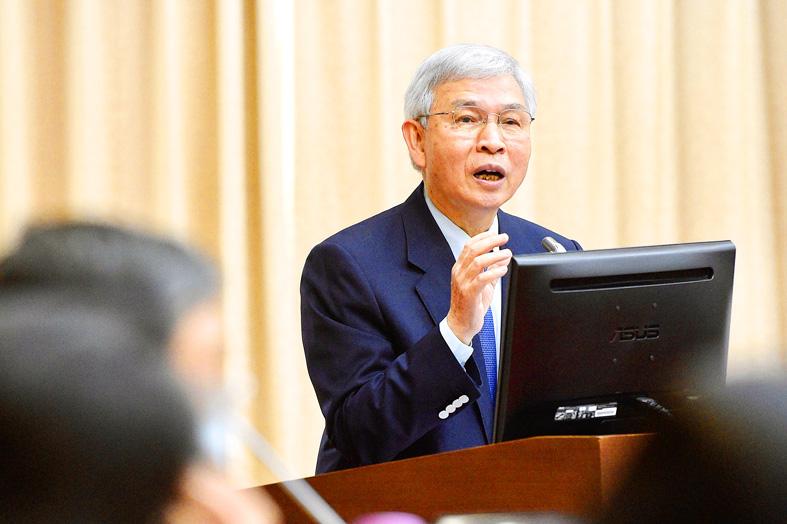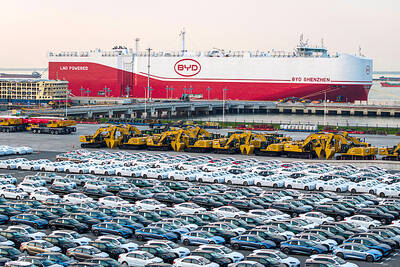Stable consumer prices, which are forecast to grow about 1.6 percent this year, indicate that Taiwan’s economy is not overheating and lend support to keeping interest rates unchanged, central bank Governor Yang Chin-long (楊金龍) said yesterday.
Yang made the remarks during a visit by lawmakers from the legislature’s Finance Committee to the central bank to inquire about monetary policy trends, and the economic outlook at home and abroad.
US Federal Reserve board members remain divided about the threat of inflationary pressures and might discuss whether to taper bond purchases during the Jackson Hole, Wyoming, economic policy symposium today, Yang added.

Photo: George Tsorng, Taipei Times
Fed members have said that US inflation of 5 percent is a temporary phenomenon to defend the bank’s money-printing policy and might hold on to current rates until early 2023, he added.
The US can invoke quantitative easing to bolster its economy, because the greenback is a major currency in which countries carry out and settle cross-border trade, Yang said.
The US dollar gains in value during bad times when investors take shelter in the currency — a tactic that other countries cannot imitate, he said.
Yang said he saw no urgency in raising interest rates in Taiwan, where inflationary pressures are mild and benign.
“Inflation sits atop the list of concerns when the central bank draws its monetary policy,” he said.
Consumer prices are expected to increase 1.6 to 1.7 percent this year, suggesting that the economy is not overheating and there is no need for sweeping tightening measures, he said.
The central bank is due to review its monetary policy next month.
Taiwan’s policy rate, currently at a record low of 1.125 percent, is not particularly loose when compared with negative interest rates in Japan and Switzerland, Yang said.
Latin American countries, such as Peru, Chile, Brazil and Mexico, have to raise interest rates to cope with imported inflation, which is not a serious issue in Taiwan, he said.
Taiwan’s economic growth, while vibrant, is largely supported by exports, which have benefited from US-China trade tensions and a severe chip shortage, Yang said.
However, domestic demand-reliant sectors have taken a hard hit from a local COVID-19 outbreak that started in May, he added.
Uneven economic growth lends support to accommodative monetary policy and the government’s plan to issue consumption vouchers to help energize domestic demand, he said.

Micron Memory Taiwan Co (台灣美光), a subsidiary of US memorychip maker Micron Technology Inc, has been granted a NT$4.7 billion (US$149.5 million) subsidy under the Ministry of Economic Affairs A+ Corporate Innovation and R&D Enhancement program, the ministry said yesterday. The US memorychip maker’s program aims to back the development of high-performance and high-bandwidth memory chips with a total budget of NT$11.75 billion, the ministry said. Aside from the government funding, Micron is to inject the remaining investment of NT$7.06 billion as the company applied to participate the government’s Global Innovation Partnership Program to deepen technology cooperation, a ministry official told the

Taiwan Semiconductor Manufacturing Co (TSMC, 台積電), the world’s leading advanced chipmaker, officially began volume production of its 2-nanometer chips in the fourth quarter of this year, according to a recent update on the company’s Web site. The low-key announcement confirms that TSMC, the go-to chipmaker for artificial intelligence (AI) hardware providers Nvidia Corp and iPhone maker Apple Inc, met its original roadmap for the next-generation technology. Production is currently centered at Fab 22 in Kaohsiung, utilizing the company’s first-generation nanosheet transistor technology. The new architecture achieves “full-node strides in performance and power consumption,” TSMC said. The company described the 2nm process as

POTENTIAL demand: Tesla’s chance of reclaiming its leadership in EVs seems uncertain, but breakthrough in full self-driving could help boost sales, an analyst said Chinese auto giant BYD Co (比亞迪) is poised to surpass Tesla Inc as the world’s biggest electric vehicle (EV) company in annual sales. The two groups are expected to soon publish their final figures for this year, and based on sales data so far this year, there is almost no chance the US company led by CEO Elon Musk would retain its leadership position. As of the end of last month, BYD, which also produces hybrid vehicles, had sold 2.07 million EVs. Tesla, for its part, had sold 1.22 million by the end of September. Tesla’s September figures included a one-time boost in

Shares in Taiwan closed at a new high yesterday, the first trading day of the new year, as contract chipmaker Taiwan Semiconductor Manufacturing Co (TSMC, 台積電) continued to break records amid an artificial intelligence (AI) boom, dealers said. The TAIEX closed up 386.21 points, or 1.33 percent, at 29,349.81, with turnover totaling NT$648.844 billion (US$20.65 billion). “Judging from a stronger Taiwan dollar against the US dollar, I think foreign institutional investors returned from the holidays and brought funds into the local market,” Concord Securities Co (康和證券) analyst Kerry Huang (黃志祺) said. “Foreign investors just rebuilt their positions with TSMC as their top target,